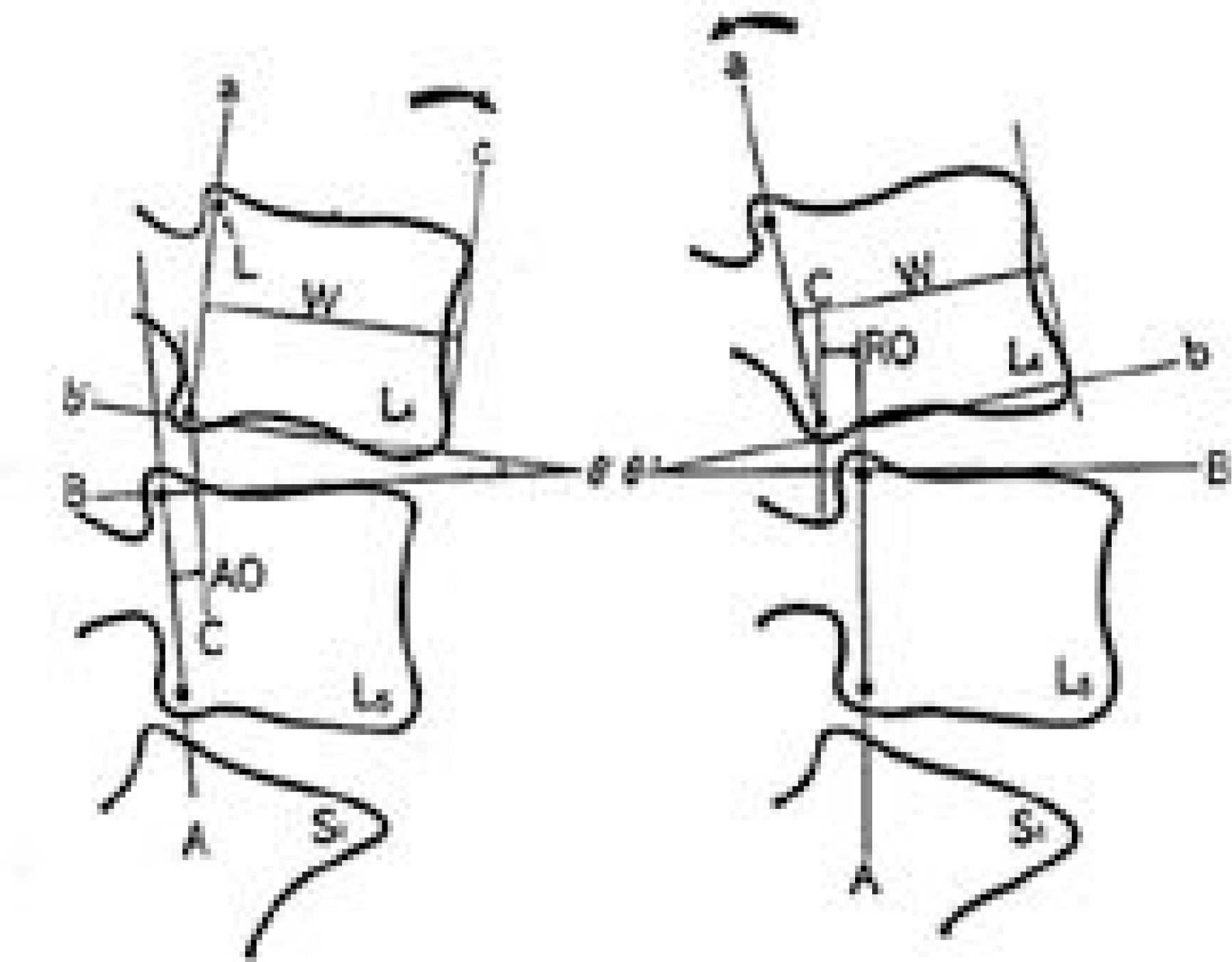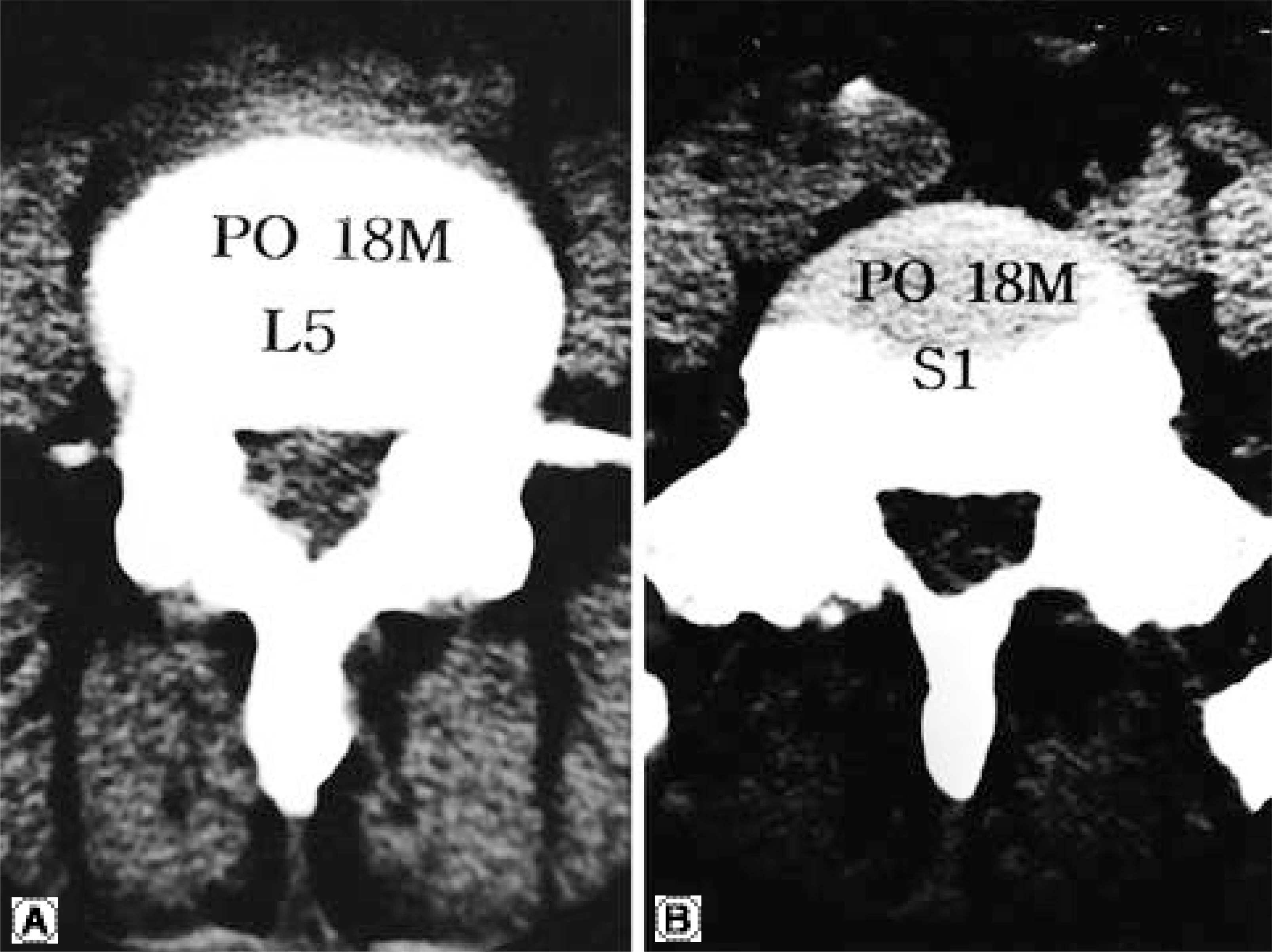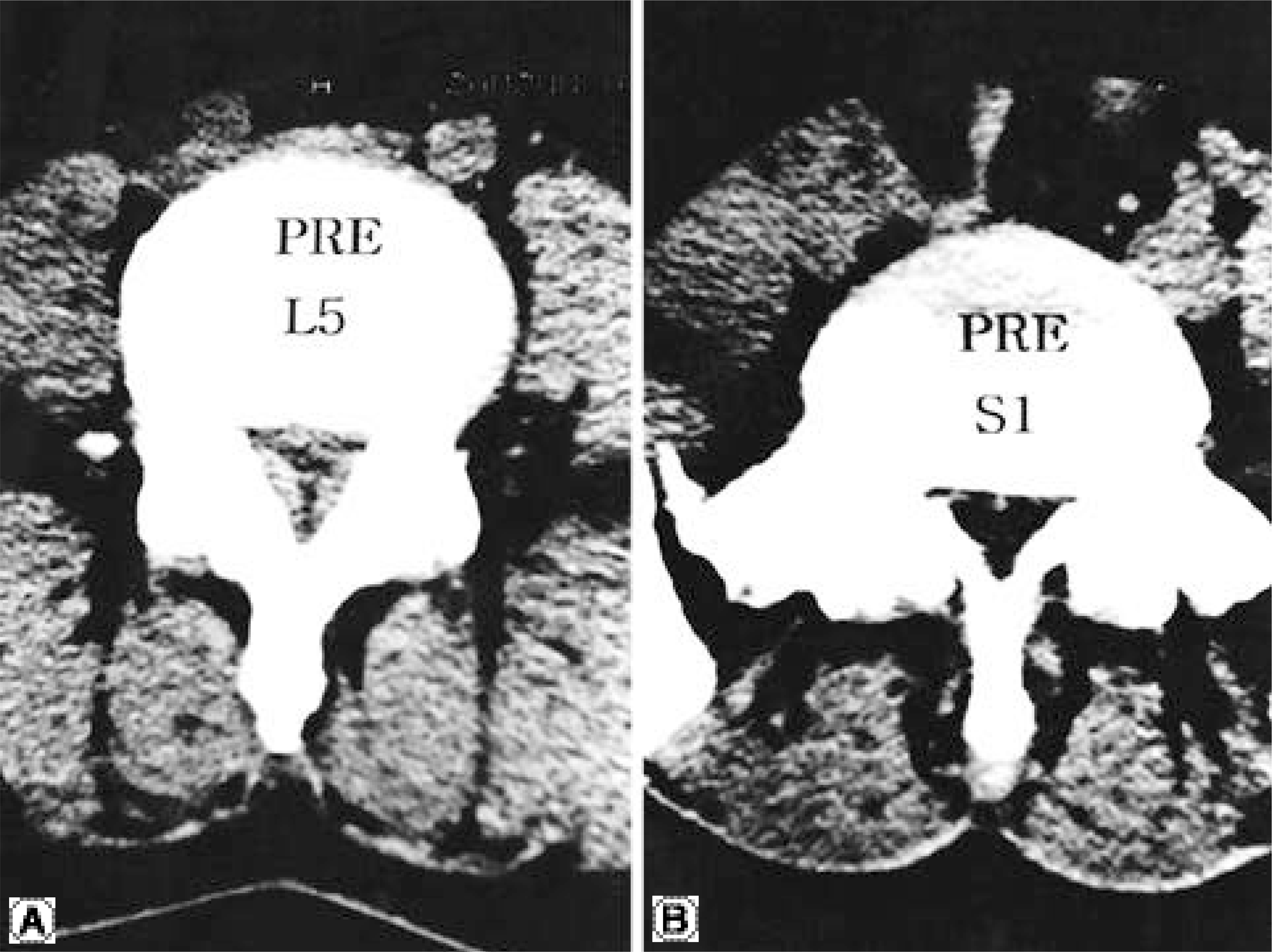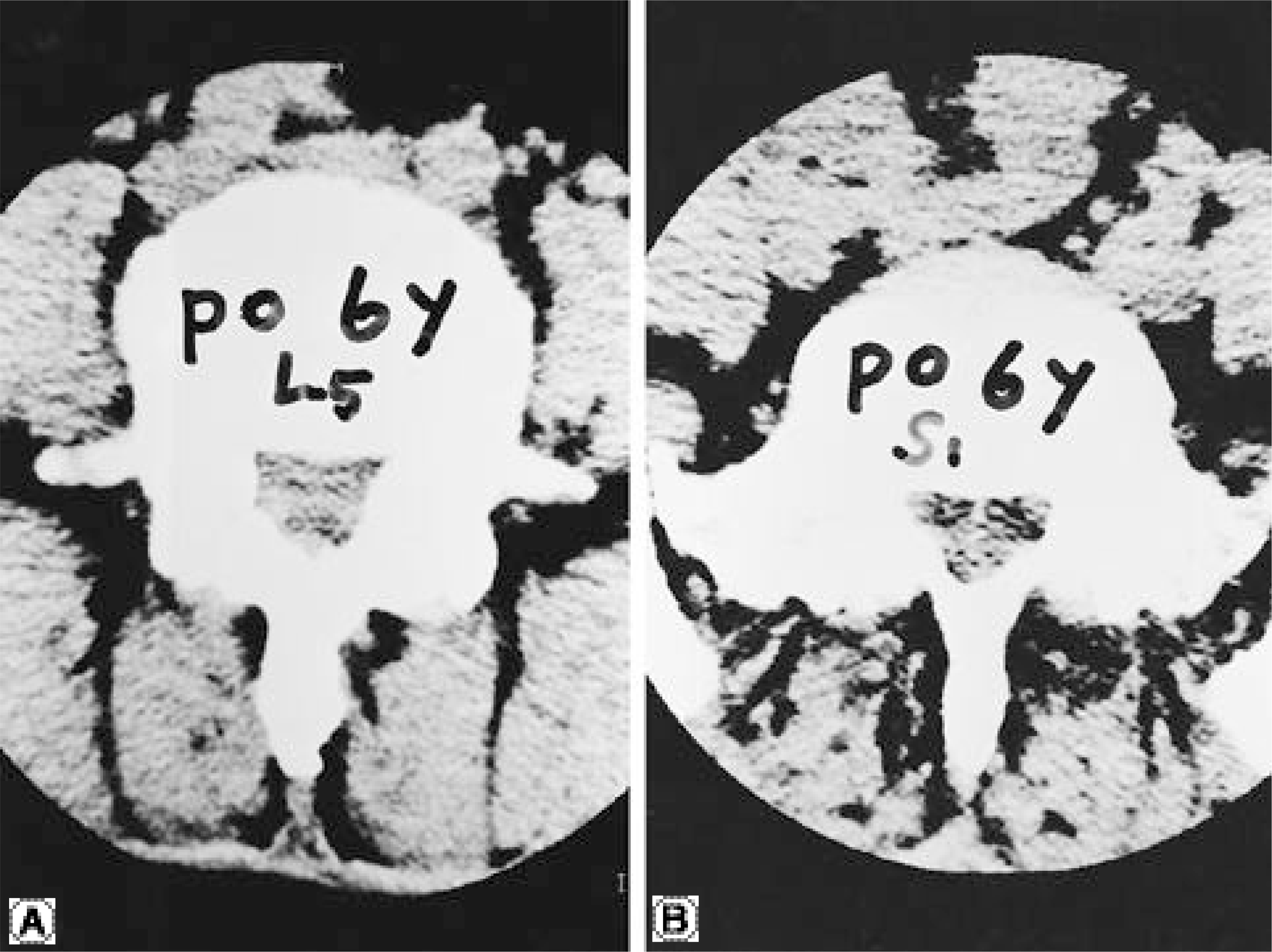Abstract
Objectives
In the operative treatment of lumbar spinal stenosis, the wide decompression and fusion method has many problems, such as a long operation time, large blood loss and the long time required to achieve solid fusion. A s a solution to these problems, a minimal decompression method was been performed, which minimizes the resection of laminae and facet joints.
Summary of Literature Review: In the operative therapy for lumbar spinal stenosis, favorable results can be obtained by simple decompression.
Materials and Methods
42 cases of degenerative lumbar stenosis, with neither segmental instability nor spondylolisthesis, underwent a minimal decompressive surgery, without instrumentation. The mean operation time and amount of blood loss were analyzed, and the clinical results evaluated according to Kim's criteria and the postoperative segmental instability by the Dupuis method. The average follow- up period was 70 months.
Results
Transfusions were not required in all cases. The mean operative times were 1hour 5minutes and 1 hour 46 minutes in the one and two segment decompressions, respectively. The clinical results, according to Kim's criteria, were excellent in 24 cases and good in 12. There was no dynamic instability in the radiographs at the last follow- up.
REFERENCES
1). Abmui K., Panjabi MM., Kramer KM. Biomechani -cal evaluation of lumbar spinals instability after graded facetectomies. Spine,. 15:1142–1147. 1990.
2). Benz RJ., Garfin SR. Current techniques of decom -pression of the lumbar spine. Clin Orthop,. 384:75–81. 2001.
3). Crock H., Crock M. A technique for decompression of the lumbar spinal canal. Neuro-Orthopedics,. 5:96–99. 1988.
4). Dupuis PR., Yong-hing K., Cassidy JD. Radiologic diagnosis of degenerative lumbar spinal instability. Spine,. 10(3):262–76. 1985.

5). Frymoyer JW., Hanley EN., Howe J. A Comparision of radiographic findings in fusion and nonfusion patients ten or more years following lumbar disk surgery. Spine,. 4(5):435–440. 1979.
6). Grob D., Humke T., Dvorak J. Degenerative lumbar spinal stenosis. Decompression with and without arthrodesis. J Bone Joint Surg,. 77(A7):1036–41. 1995.

7). Jeffrey M Spivak. Current Concepts of Review-Degener -ative Lumbar Spinal Stenosis. J Bone Joint Surg,. 80(A):1053–66. 1998.
8). Kim NH., Seo IK. The Effect of Anterior Interbody Fusion in Lumbar Hernated Nucleus Pulposus. J of Kor Orthop Assoc,. 21(2):202–10. 1986.
9). Leong JCY., Grange WJ., Fang D. Long term results of lumbar intervertebral disc prolapse. Spine,. 8:793–799. 1983.
10). Shim DM., Kim SS., Han HJ., Lee BC., Shin JH. Selective spinal root block method used for testing lumbar spinal disease. J Korean Spine Surg,. 1:293–299. 1996.
11). Shin BJ., Shin YS., Kwon H., Yim SJ., Kim DS., Choi CU. The results of treatment of multilevel spinal stenosis. J Kor Spine Surg,. 3:161–168. 1996.
13). S. Terry Canale. International Edition of Campbell's Operative Orthopaedics. 10th ed.Philadelphia: Mosby;p. 1959–1961. 2003.
14). Thomas J. Gill and Michael D. Mason. Assessment of neuroforaminal decompression in degenerative spinal stenosis. Clin Orthop,. 348:135–139. 1998.
15). White AA III., Panjabi MM. Clinical biomechanics of the spine. 2nd ed.Philadelphia: JB Linppincott Co;1990.
Fig. 1.
Operative method A. After removal of ligamentum flavum, dura is exposed. B. With additional removal of part of isthmus, nerve root is exposed. C. Retracting the nerve root and dura medially with root retractor, we decompressed the lateral recess.

Fig. 2.
Intraoperative findings A. After removal of ligamentum flavum, dura is exposed (white arrow). B. With additional removal of part of isthmus, nerve root is exposed (black arrow).

Fig. 3.
Dupis method of measuring the translation and angulation of segmental motion on flexion-extension radi-ographs. Translation=RO-(-AO), Angulation=Θ +-(-Θ -).

Fig. 4.
Preoperative CT findings. In trefoil spinal canal, bilateral ligamentum flavum thickening is prominent in L4-5 space (A), both lateral recesses are narrow due to ligamentum flavum thickening and facet joint hypertrophy in L5-S1 space (B).

Fig. 5.
Postoperative 18months CT findings. Spinal canal is enlarged and both lateral recesses are decompressed in L4-5 (A) and L5-S1 space (B).

Fig. 6.
Postoperative 6years CT findings. The CT film of postoperative 6years shows no significant change such as overgrown new bone comparing to that of postoperative 18months.

Table 1.
Distribution of Op. segments
| Op. segments | Numbers |
|---|---|
| L2-3 | 2 cases |
| L3-4 | 15 cases |
| L4-L5 | 35 cases |
| L5-S1 | 12 cases |
| Total | 64 cases |
| 1 segment | 20 patients |
| 2 segments | 22 patients |
| Total | 42 patients |
Table 2.
Associated pathologies (in 64 segments)
| Associated pathology | Segments | Percent |
|---|---|---|
| Ligamentum flavum thickening | 50 | 78% |
| Facet joint hypertrophy | 47 | 74% |
| Combined with HIVD | 41 | 64% |
| Disc degeneration | 25 | 39% |
Table 3.
OP. time and blood loss
| Op. time | Intra. Op.(cc) | Post. Op.(cc) | Total(cc) | |
|---|---|---|---|---|
| 1 segment | 1hr.5min | 217 | 73 | 290 |
| 2 segments | 1hr.46min | 283 | 168 | 451 |
Table 4.
Kim's criteria for clinical result.




 PDF
PDF ePub
ePub Citation
Citation Print
Print


 XML Download
XML Download